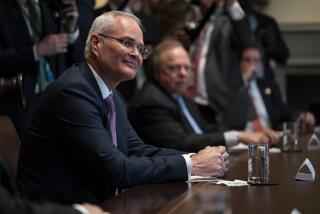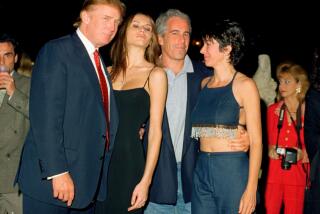Vinson & Elkins’ Turn in the Enron Spotlight
- Share via
Just six weeks after Enron Corp. directed its lawyers at Vinson & Elkins to investigate allegations about its secret partnerships, a report came back Oct. 15 saying everything was just fine. No need for “further widespread investigation,” the lawyers added.
The very next day, Enron delivered the first in a series of shocks when it slashed shareholder equity by $1.2 billion, partly due to the partnerships. Sixteen days later the board of directors launched their own inquiry, which quickly found massive improprieties. And on Dec. 2, Enron filed for bankruptcy protection.
“Even as the Titanic was sinking, there were certain rooms that were perfectly dry,” said Matthew Spitzer, USC Law School dean. “If you asked someone in one of those rooms, ‘See any water?,’ they’d say no. That’s the sort of investigation Vinson & Elkins did.”
The law firm, one of the biggest and most highly regarded in the country, says it had no clue about the real nature of Enron’s problems. The two versions of reality will be debated this morning in Washington as the House Energy and Commerce subcommittee on oversight and investigations grills Vinson & Elkins’ top management.
“We know that Enron did not collapse in a vacuum of advice,” said subcommittee Chairman James C. Greenwood (R-Pa.). “Even if the attorneys recommended Enron follow a perfectly legal course of action, maybe the laws need to be reformed.”
Greenwood also said he was curious why Enron’s own investigation, run by Enron board member and University of Texas Law School Dean William Powers, “was able to determine things after the fact that Vinson & Elkins was either unable or unwilling or not directed to discover.”
The Powers report was critical of V&E;, saying Enron “relied heavily” on the law firm’s perceived approval on “the structure and disclosure” of the partnerships. V&E; “should have brought a stronger, more objective and more critical voice to the disclosure process.”
Testifying for V&E; will be managing partner Joe Dilg and partner Ronald Astin, who worked directly with Enron.
Four current and former Enron lawyers also will testify, including former general counsel James Derrick. Before joining Enron, Derrick worked at V&E.;
In an interview Wednesday, Harry Reasoner, former Vinson & Elkins managing partner and the firm’s designated spokesman for Enron issues, said the energy company’s collapse was a tragedy for the people who worked there and a sad event for him personally.
“When something like that happens,” he noted, “all of us say, ‘What could have been done differently?’”
The answer, at least as far as the 860-lawyer Vinson & Elkins is concerned: nothing.
Using a metaphor that also has been employed by former Enron Chief Executive Jeffrey K. Skilling, Reasoner said Enron fell apart in “a perfect storm” of events: A loss of confidence in the company’s accounting resulted in a downgrade of debt which caused a liquidity crunch.
“I don’t believe, if you look at it in perspective, that you can say we or any other lawyer had anything to do with it,” Reasoner said.
Some people sharply disagree with this. One Enron lawyer, speaking anonymously, put it this way: “Where was the oversight? Where was the counsel saying, ‘Even if this is technically legal, should we be doing it?’ That’s where the senior people at V&E; failed, and that’s where Enron’s own senior counsel failed.”
If V&E; had strayed from purely legal advice, people would have said, “You’re lawyers who work by the hour, and you don’t know anything about this,” Reasoner said.
So far, at least, Enron’s legal counsel is suffering much less than its accounting firm. While Andersen is hemorrhaging clients and desperately trying to ward off an indictment, Vinson & Elkins is largely unscathed. Headhunters are calling its lawyers, Reasoner said, but none are fleeing. Neither are clients.
One reason that V&E; is getting off lightly: accountants are vouchsafing the accuracy of documents for the investing public, while a law firm is only responsible to its client. So everyone can sue Andersen, and just about everyone is. But under Texas law V&E; can be easily sued only by Enron.
“In 20 years of suing lawyers, I’ve never done it on behalf of a third party,” said Randy Johnston, a legal malpractice attorney in Dallas. “Whoever decides to take V&E; on is taking on a huge task.”
To successfully mount a suit against a lawyer, a shareholder must prove that the lawyer fraudulently misrepresented certain facts or conditions, and that the lawyer “had reason to expect” the shareholder would rely on those misrepresentations.
But even this wouldn’t be easy, as the Texas Supreme Court demonstrated in June in a misrepresentation case involving the accounting firm Ernst & Young. Such cases, the court ruled, applied in only very specific circumstances.
Early in Enron’s collapse, two law firms did name Vinson & Elkins in class-action suits. But after talking with V&E;’s outside counsel, legendary Texas lawyer Joe Jamail, the firms dropped the suits. Since then, V&E; has largely stood outside the fray.
“For me to be interested in suing V&E;, I would want some type of a representation by them in a publicly distributed document which I could demonstrate that either they knew was false or should have known was false,” said Johnston.
He doesn’t know of any such documents. Nor apparently does anyone else. “The fact that they haven’t been sued yet suggests they don’t exist,” the lawyer said.
That leaves Enron as a potential plaintiff. The new chief executive, Stephen F. Cooper, has made noises about looking for cash anywhere he can find it, but no suit has yet been filed.
Meanwhile, V&E; is rapidly distancing itself from its former top client, which provided $35 million, or nearly 8% of its $455 million in 2001 revenue.
“We have terminated our representation of Enron,” Reasoner wrote to clients last month.
The letter stressed that the law firm and the client had never been that close in the first place. “Enron was represented by an extremely able legal department of some 250 lawyers,” Reasoner wrote. Furthermore, he noted, all V&E; lawyers worked through Enron’s legal department, a standard practice at large corporations.
But the Enron lawyer remembers a more intimate relationship. “V&E; developed social relationships with the businesspeople at Enron. They would play golf together, gossip together,” this lawyer said. “Once you have that sort of personal relationship with your outside counsel, it’s a little more difficult for them to tell you the bad news.”
Both V&E; and Enron are home-grown Houston entities, although the law firm is much older. James Elkins was a former county judge who joined up with William Vinson in 1917 to start a two-man practice. Judge, as Elkins was simply called, was the dominant partner whose influence lingered for decades.
*
“Vinson & Elkins lawyers are on the boring, arrogant side, not the roll the dice and take a shot side,” said Gerald Treece, South Texas College of Law dean. “They say, ‘Go slow.’ They play hard, but fair.”
It’s a reputation that is helping them as their work for Enron comes under scrutiny. When Enron Sherron S. Watkins, a vice president in the company, first alerted Chairman Kenneth L. Lay in August to the accounting improprieties, she warned against using Vinson & Elkins to examine them. “Can’t use V&E; due to conflict,” she wrote, noting the firm had provided some so-called true-sale opinions on several deals.
Nevertheless, V&E; did the review. “In retrospect, they probably should have suggested an outside counsel,” said Spitzer of USC. “The allegations required them to review, in part, the propriety of their own actions. But when you ask someone. ‘Did you do anything wrong?,’ the answer is almost always ‘I don’t think so.’”
More to Read
Inside the business of entertainment
The Wide Shot brings you news, analysis and insights on everything from streaming wars to production — and what it all means for the future.
You may occasionally receive promotional content from the Los Angeles Times.










